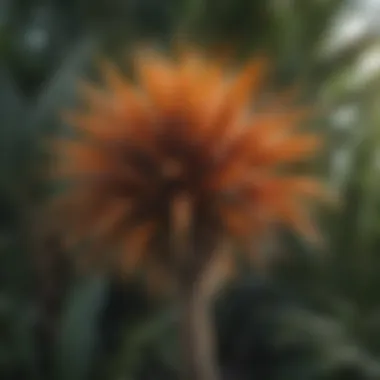Understanding the Spiky Palm-Like Plant: Care and Conservation


Intro
The spiky palm-like plant has attracted attention due to its distinctive appearance and ecological importance. This unique plant is found in various habitats and plays a crucial role in its ecosystem. Understanding its features helps in both cultivation and conservation efforts. This article will explore these aspects in detail.
Fascinating Facts About the Plant
Unique Characteristics
The spiky palm-like plant is easily identifiable thanks to its distinctive, sharp-edged leaves that can resemble spikes. These adaptations serve both aesthetic and functional purposes. The physical structure is designed to reduce water loss, making it resilient in harsh climates. Additionally, some varieties may exhibit a unique coloration, adding to their appeal in gardens and landscapes.
Ecological Roles
Beyond its appearance, the spiky palm-like plant contributes to the environment in various ways. It provides habitat for numerous insect species and acting as a food source for others. Furthermore, these plants may help in soil stabilization, thus preventing erosion.
Behavior and Habitat
Natural Habitats
These plants thrive in diverse environments ranging from arid deserts to humid coastal areas. Their adaptability to different climatic conditions enables them to flourish in various ecosystems. The spiky palm-like plant often prefers well-drained soils and can endure prolonged periods of drought, which is a beneficial trait in areas susceptible to climate change.
Interaction with Other Species
The interaction between the spiky palm-like plant and other species profoundly influences local biodiversity. It attracts specific pollinators, such as bees and certain birds, which rely on its flowers for nectar. These relationships are essential for the health of ecosystems, as they promote pollination and seed dispersal.
Care Techniques
Caring for the spiky palm-like plant requires understanding its needs. Here are some essential tips:
- Soil Requirements: Well-draining soil is preferable. Amending with sand or gravel can enhance drainage.
- Watering: Water sparingly, allowing the soil to dry completely between watering sessions.
- Light: Provide full sun conditions, which are vital for optimal growth.
By adhering to these care solutions, enthusiasts can cultivate healthier plants that will thrive and contribute positively to their surroundings.
Conservation Concerns
The spiky palm-like plant faces various threats, including habitat loss due to urbanization and climate change. Conservation efforts are crucial to preserving these species for future generations. Protecting their natural habitats ensures biodiversity and ecosystem stability.
Intro to the Spiky Palm-Like Plant
The spiky palm-like plant is a remarkable species that draws interest from various fields, including botany, ecology, and horticulture. Understanding its characteristics is crucial for recognizing how it fits into its ecosystem and why conservation efforts are essential. These plants are often distinguishable by their unique physical appearance, which features spiky leaves and a varied structure that adapts to their environment.
There are several benefits associated with studying the spiky palm-like plant. First, knowledge about its care and cultivation can assist gardeners and plant enthusiasts in maintaining healthy specimens. A better understanding of their requirements can lead to a more successful gardening experience. Additionally, understanding how this plant interacts with its environment fosters appreciation of biodiversity and ecological balance.
Care must also be taken to consider the conservation status of these plants. Many spiky palm-like species face threats from habitat destruction and climate change. Recognizing these challenges is a step towards promoting sustainable practices and protecting our natural resources. Each plant plays a critical role in its local ecosystem, making it vital to ensure their preservation.
By uncovering the intricacies of the spiky palm-like plant in this article, readers will not only learn about its unique features and care techniques but also understand its broader ecological significance. Ultimately, the spiky palm-like plant serves as a reminder of the intricate connections within nature and the need for responsible stewardship of our environment.
Etymology and Classification
Etymology and classification are critical for understanding the spiky palm-like plant. Names provide insight into the plant's history and cultural significance. Scientific classification helps to accurately identify species and understand their relationships within the ecosystem. This section delves into the scientific name and common names of the spiky palm-like plant, highlighting their relevance for various audiences, including veterinarians, wildlife biologists, and families.
Scientific Name and Taxonomy
The scientific name of the spiky palm-like plant belongs to the family Arecaceae, commonly known as the palm family. The specific genus and species may vary depending on the exact type of plant being referred to. For instance, the widely recognized species, such as Chamaerops humilis, presents as a common representation of this group.


Taxonomy categorizes the plant hierarchically. It includes kingdom, phylum, class, order, family, genus, and species. Each level provides context about the plant's characteristics and how it fits into the broader botanical classification. By understanding this classification, one can discern how this particular species interacts with both its environment and related plant species.
Common Names and Variations
Common names for the spiky palm-like plant vary widely based on region and culture. Terms like “fan palm” or “European fan palm” may resonate with individuals familiar with its physical characteristics.
These names often reflect the plant's appearance or usage. Variations can result from local dialects and naming conventions, which contribute to the diversity of recognition across different cultures. Using common names makes communication easier among various groups, yet it's vital to accompany these with their scientific classifications for clarity.
In summary, understanding the etymology and classification of the spiky palm-like plant enhances appreciation for its role in our ecosystems. Knowing its scientific and common names enables effective communication among those who interact with or study these remarkable plants.
Morphological Features
Morphological features are crucial for understanding the spiky palm-like plant. Analyzing these characteristics helps in identifying the plant accurately and appreciating its ecological roles. Knowing the morphological aspects also plays a significant role in cultivating and conserving these plants. In this section, we explore vital elements of the spiky palm-like plant's morphology, detailing its leaf structure, spiny attributes, and growth patterns.
Leaf Structure and Arrangement
The leaf structure of the spiky palm-like plant is distinct, characterized by long, narrow leaves that are often armed with spines at their edges. These leaves typically grow in rosettes, lending a unique aesthetic to the plant. The structure is adapted to conserve water, making it suitable for arid environments. Each leaf can be several feet long, offering a dramatic presence. Moreover, the arrangement affects how the plant absorbs sunlight, maximizing its photosynthetic capacity.
Spiny Characteristics
Spiny characteristics are one of the most noticeable features of the spiky palm-like plant. The spines are not just for show; they serve multiple ecological purposes. The spines can protect the plant from herbivores, deterring animals that might otherwise consume it. In addition, these spiny projections can assist in collecting moisture from the air, a clever adaptation for survival in dry habitats. It is this blend of defense and utility that makes these plants fascinating subjects of study in ecology.
Growth Patterns and Height
Growth patterns of the spiky palm-like plant show a remarkable versatility. They can range from low-growing forms to tall specimens that reach heights of up to 15 feet. The growth can depend on environmental factors such as soil quality and water availability. Some plants may display slow growth in more challenging conditions while thriving in a well-tended garden. This adaptability makes them suitable for various landscapes, from wild settings to cultivated gardens, impressing those who study them.
Understanding these morphological features contributes not only to the appreciation of the spiky palm-like plant but also aids in its conservation efforts. Accurate identification and knowledge of its growth habits are essential for managing its preservation in the wild.
Habitat and Geographic Distribution
Understanding the habitat and geographic distribution of the spiky palm-like plant provides insight into its ecological preferences and its role within various ecosystems. The specific environments where it thrives are essential not only for its survival but also for the health of the entire habitat. Recognizing these locations helps in effective conservation efforts and informs cultivation practices. This section will delve into the natural habitats of the spiky palm-like plant and explore its global distribution patterns.
Natural Habitats
The spiky palm-like plant is typically found in diverse ecosystems. These include coastal regions, arid deserts, and tropical forests. Each of these environments offers unique conditions that this plant leverages to flourish.
- Coastal Areas: In coastal regions, the plant benefits from the moisture in the air and rich soil deposited by tidal actions. Salt tolerance is also a significant advantage in these habitats.
- Deserts: In arid environments, the plant adapts to low water availability. It develops deep root systems to access groundwater, allowing it to survive in harsh conditions.
- Tropical Forests: The understorey of tropical forests provides ample humidity and shade, creating a microclimate suitable for growth.
Recognizing these habitat types is crucial. It informs both conservation strategies and horticultural practices, ensuring the plant can thrive in environments that most closely mimic its native conditions.
Global Distribution
The spiky palm-like plant is not limited to a single geographic area but has a broad global presence. This plant can be found in regions spanning from the subtropics to tropical areas across continents such as Africa, Asia, and South America.
- Africa: It is prominent in the coastal regions of East Africa.
- Asia: Countries like India and Thailand showcase a rich diversity of these plants in both wild and cultivated settings.
- South America: In tropical areas, this plant contributes to the biodiversity of rainforests.
Overrall, the distribution of the spiky palm-like plant reflects its adaptability to varied climates. Conservation efforts should focus on preserving these distributions to ensure the plant continues to thrive amid changing environmental conditions.
Understanding the natural habitat and global distribution is vital for effective conservation and management strategies.
Ecological Role
The ecological role of the spiky palm-like plant is vital in maintaining both its immediate environment and the broader ecosystem. Understanding this role provides insight into how these plants interact with other organisms and contribute to ecological balance. Their presence is beneficial in various ways, from offering habitat to wildlife to influencing soil quality. Recognizing these functions helps emphasize the importance of conservation efforts aimed at protecting these unique plants.
Interactions with Other Species


Spiky palm-like plants engage in numerous interactions with a variety of species. These interactions can be mutualistic, neutral, or even parasitic. For example:
- Pollination: Many spiky palm-like plants depend on specific insects for pollination. This relationship ensures that both the plant and the insect benefit, as the plant is able to reproduce, while the insect obtains food.
- Habitat: These plants provide shelter and nesting materials for birds and small mammals. In return, these species may help in seed dispersal, increasing the spread and genetic diversity of the plants.
- Competition: They can also compete with other plant species for resources such as nutrients, light, and water. Understanding these dynamics is crucial for managing their habitats effectively.
The interactions are complex and showcase the interconnectedness of life forms within an ecosystem.
Contribution to Ecosystem Health
The contribution of spiky palm-like plants to ecosystem health is significant. They play a role in maintaining soil integrity and promoting biodiversity. Below are some ways they contribute:
- Soil Stability: Their root systems often help bind the soil together, reducing erosion. This is especially important in areas prone to heavy rainfall or wind.
- Biodiversity Hotspots: By providing food and habitat, these plants support a range of wildlife, fostering biodiversity. This, in turn, makes ecosystems more resilient to changes.
- Nutrient Cycling: As these plants grow and decay, they contribute organic material to the soil, enhancing its fertility. This process is essential for the health of flora that depends on nutrient-rich soil.
The health of ecosystems is closely tied to the presence and well-being of plants like the spiky palm-like plant, highlighting the need for effective conservation measures.
Cultivation and Care
The cultivation and care of the spiky palm-like plant is critical for those who wish to maintain its health and longevity. Understanding its specific needs enhances its growth and ensures it thrives in various environments. Careful attention to soil composition, sunlight exposure, and proper watering practices not only supports the plant’s aesthetic appeal but also contributes to its ecological role. Thus, providing the right conditions helps in sustaining biodiversity and improves the overall vigor of these unique plants.
Soil and Sunlight Requirements
Soil and sunlight are essential for the development of the spiky palm-like plant. These plants prefer a well-draining soil mix, often composed of sand, perlite, or peat to avoid waterlogging. The pH should be slightly acidic to neutral, ideally between 6.0 and 7.0. This balance encourages healthy root growth and nutrient absorption.
In terms of sunlight, the spiky palm-like plant thrives best in bright, indirect light. Direct sunlight can scorch its leaves. For indoor cultivation, a west or east-facing window is ideal. For outdoor plants, partial shade is favorable, especially during the hottest parts of the day. To sum up, here are the key points regarding soil and sunlight requirements:
- Well-Draining Soil: Use sand, perlite, or peat.
- pH Level: Aim for 6.0 to 7.0.
- Light Conditions: Bright, indirect light is optimal.
- Outdoor Location: Provide partial shade from intense sun.
Watering and Fertilization Practices
Watering and fertilization are also vital aspects of cultivating the spiky palm-like plant. It is best to water these plants thoroughly but infrequently. This strategy prevents overwatering, which can lead to root rot. The rule of thumb is to allow the top two inches of soil to dry out before rewatering.
Fertilization should occur during the growing season, typically from spring to early autumn. Using a balanced liquid fertilizer diluted to half strength every four to six weeks will support healthy growth. Here’s a quick guideline for watering and fertilization:
- Watering Frequency: Allow soil to dry; water thoroughly.
- Fertilization: Use balanced liquid fertilizer in growing season.
- Dilution: Fertilizer should be diluted to half strength.
Common Pests and Diseases
Like all plants, the spiky palm-like plant is susceptible to certain pests and diseases. Common pests that often affect these plants include spider mites, aphids, and mealybugs. Regular inspection is essential. If detected early, pests can often be managed with neem oil or insecticidal soap.
Fungal diseases, such as root rot, can occur if conditions are too damp. It is crucial to maintain proper watering practices and ensure good air circulation around the plant. Here are some notable points:
- Common Pests: Spider mites, aphids, mealybugs.
- Management Strategy: Neem oil or insecticidal soap for pest control.
- Fungal Diseases: Monitor damp conditions to prevent root rot.
Remember: Proper care and maintenance allows the spiky palm-like plant to thrive, enhancing not only its beauty but its role in the environment.
Cultural Significance
Cultural significance of the spiky palm-like plant can be appreciated through various lenses, including traditional practices and symbolism across different cultures. Understanding this importance helps in recognizing how deeply intertwined the plant is with human activities and beliefs. It serves not only as a botanical specimen but also as a component of cultural identity, rituals, and even economic activities.
Use in Traditional Practices
The spiky palm-like plant is often utilized in traditional practices of various communities around the world. Its tough leaves and distinctive shape make it suitable for different applications. For instance, in some regions, the leaves can be woven into baskets or mats. This craftsmanship showcases skills passed down through generations.
Moreover, some cultures use these leaves in ceremonial contexts, where they may adorn altars or be part of festive decorations. These practices speak to the plant's role in maintaining cultural heritage and providing a tangible link to ancestry. In addition, certain indigenous groups have historically used parts of the plant for medicinal purposes, highlighting its importance in traditional healing practices.


Symbolism in Different Cultures
In many cultures, the spiky palm-like plant carries rich symbolism. It often represents resilience and strength due to its robust nature. In areas with harsh climates, the ability of this plant to endure and thrive reflects the spirit of the local communities.
Additionally, the plant may be associated with life and regeneration. Its lifecycle can symbolize the importance of nurturing and healing in various belief systems. In some cultures, the plant’s unique form inspires artistic expressions, from paintings to sculptures, further embedding it into cultural narratives.
The spiky palm-like plant stands as a testament to human adaptability, underpinning practices and arts that celebrate nature and heritage.
Understanding these cultural dimensions provides a more holistic view of the plant’s role. It emphasizes the necessity for conservation efforts not just for ecological balance, but also to preserve cultural identities that rely on these unique species.
Threats and Conservation
Conservation of the spiky palm-like plant is critical given its unique ecological role and growing vulnerability. Understanding the threats it faces and the necessity for conservation strategies allows for informed actions that can secure its future in natural habitats. Protecting this plant not only aids in maintaining biodiversity but also contributes to the health of the ecosystems in which it resides.
Habitat Loss and Climate Change
Habitat loss is one of the most significant threats to the spiky palm-like plant. Urbanization, deforestation, and agricultural expansion often encroach on its native environment. This encroachment reduces viable living areas, which compromises the plant's ability to grow and reproduce.
Climate change compounds these issues through altered rainfall patterns and rising temperatures. Many species, including the spiky palm-like plant, are unable to adapt quickly to these rapid changes. For instance, prolonged drought can hinder its growth while increased rainfall can lead to erosion and nutrient depletion in the soil.
Some key factors include:
- Urban Development: Expansion of cities removes vital habitats.
- Agricultural Practices: Intensive farming leads to habitat degradation.
- Climate Variability: Shifts in temperature and precipitation patterns disrupt growth cycles.
"The survival of the spiky palm-like plant is not just about its own species but the entire ecosystem it supports."
As its habitat shrinks, the implications for local wildlife increase. Animals that depend on the plant for food or shelter face a greater risk of extinction. Thus, habitat conservation is imperative for the survival of the spiky palm-like plant and the broader biological communities it supports.
Conservation Strategies
To combat threats, effective conservation strategies must be developed and implemented. These strategies can take various forms, from legal protection to community engagement initiatives. Some of the prominent approaches include:
- Protected Areas: Establishing reserves where the plant can thrive without human interference.
- Reforestation Projects: Reintroducing native species in areas where habitat has been lost.
- Sustainable Agricultural Practices: Encouraging farming techniques that minimize environmental impact.
- Research and Monitoring: Conducting studies on plant health and population dynamics can inform future conservation efforts.
Engaging local communities is also vital. By raising awareness about the significance of the spiky palm-like plant, communities can serve as active participants in its conservation. This can foster a sense of ownership over local biodiversity and encourage sustainable practices that benefit both humans and the ecosystem.
Epilogue
In summary, the exploration of the spiky palm-like plant reveals its significance in various aspects of both nature and human life. Understanding this plant encompasses not only its physical characteristics but also its ecological and cultural relevance.
This article has detailed the unique features that distinguish the spiky palm-like plant from similar species. Its spiny leaves, specific growth patterns, and habitat needs have been examined to provide a comprehensive overview for enthusiasts, gardeners, and experts.
As discussed, these plants serve vital roles in their ecosystems. They interact with numerous species, contributing to biodiversity and the health of their habitats. The implications of habitat loss and climate change have also been highlighted, emphasizing the urgency to protect these plants through focused conservation efforts.
There are practical benefits to caring for the spiky palm-like plant, which include understanding its watering and fertilization needs. By providing suitable conditions, individuals can cultivate healthy plants that thrive and contribute positively to their environments.
Effective conservation requires both awareness and action. As stewards of nature, it is our responsibility to protect and nurture such unique species.
For further reading, you can explore more about plants and their ecological roles on reliable sources like Wikipedia and Britannica.
Importance of Comprehensive References
- Supports Claims: References validate statements made in the article. For instance, claims regarding the plant's ecological contributions can be supported by studies from Wikipedia or Britannica.
- Encourages Further Research: Citations serve as a springboard for readers looking to learn more. They can delve into complex topics or explore specific areas, promoting a deeper understanding of the plant.
- Enhances SEO: Including well-known references can improve search engine visibility. This can attract more readers, as many might search for specific studies or articles about the spiky palm-like plant.
Key Considerations for References
- Relevance: Choose sources that are directly related to the spiky palm-like plant, ensuring the information is pertinent.
- Date: Opt for more recent studies or publications to present current knowledge. This is particularly crucial in fields like ecology, where data can quickly change.
- Diversity: Incorporate a mix of sources, including scientific journals, botanical databases, and environmental organizations, to provide a rounded perspective.
By ensuring each statement in the article is backed by an appropriate reference, the text not only becomes more trustworthy but also enriches the reader's experience.
In summary, the References section is indispensable for reinforcing the information shared about the spiky palm-like plant. It supports the credibility of the article and serves as a valuable tool for those eager to expand their knowledge further.







